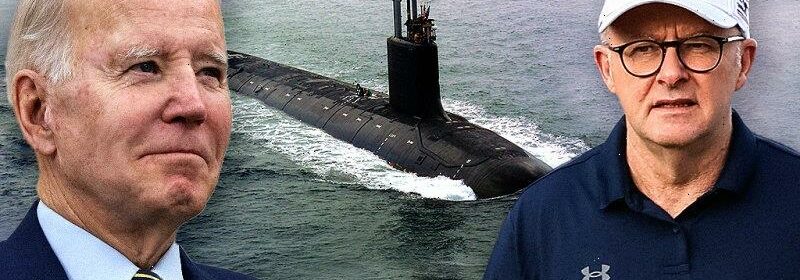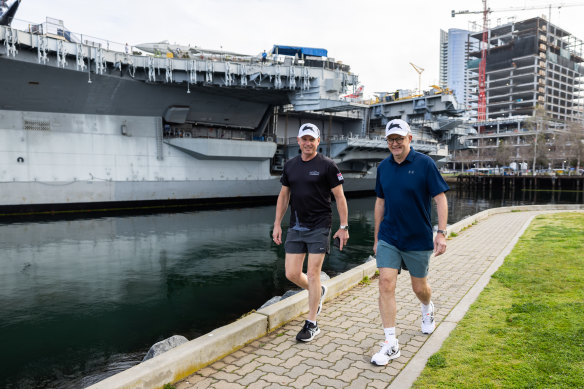Missiles and people: Why Australia is scaling up AUKUS pact

San Diego: A key measure of the fateful importance of the AUKUS alliance is that an idea devised by a conservative government is about to be made an irreversible reality by a Labor leader and his cabinet.
Prime Minister Anthony Albanese inherited the pact from his predecessor, Scott Morrison, but is taking full ownership after months of work to transform Australian naval power.
Australian Chief of Navy Vice Admiral Mark Hammond and Prime Minister Anthony Albanese in San Diego with the USS Midway Museum in the background.Credit:Alex Ellinghausen
This is an essential fact that cements the commitment to nuclear-powered submarines. Remember, Albanese has always believed there was a deception in the AUKUS announcement in September 2021. While Morrison assured United States President Joe Biden that the Coalition government had briefed Labor to gain bipartisan support, Albanese felt he did not gain the full consultation this implied.
So Albanese had good cause to question the pledges from Morrison – and, possibly, abandon them.
Rather than scale down the AUKUS project, however, he wants to scale it up. The announcement on Tuesday will bring forward the arrival of US submarines in Australian waters in the 2020s, commit to the Virginia-class submarines for the 2030s and embark on the mammoth industrial task of completing Australian-made submarines in the 2040s.
Albanese, backed by Deputy Prime Minister and Defence Minister Richard Marles, will embed AUKUS in defence and industry policy because the advice from the Australian Defence Force is that the nation must have a more powerful submarine fleet, and this means nuclear propulsion.
Three factors shape this decision.
First, the strategic calculation is that Australia must be able to defend open sea routes and communication lines when it is wholly reliant on international trade. The nation’s economic wellbeing depends on accessing those sea routes. As an island continent, it is vulnerable to any threat to 16 undersea cables. This would not matter if Australia could assume unfettered access to sea lanes, but it cannot assume this in a world where major powers flout international law – witness Russia in Ukraine and China in the South China Sea. If Australia cannot assume open access to the maritime arena, it should seek to ensure access.
Second, the government believes Australia’s existing fleet will become too vulnerable. The Collins-class submarines use diesel-electric power systems that require them to stay close to the surface for hours at a time so they can draw air into their systems. This exposes them to detection. Crucially, the advice from Defence is that this risk is increasing because quantum computing and artificial intelligence are making satellite and other forms of surveillance more powerful. The shift to nuclear propulsion dramatically reduces the risk.
Third, the Royal Australian Navy wants a new fleet with greater power. The conclusion is that Australia needs submarines that can go further, faster and remain on-station for longer. A Collins-class submarine takes 10 days to travel from Perth to Sydney; a Virginia-class can do it in three. One takes 30 days to get to Hawaii; the other needs only 10. In addition, the interim and future vessels will carry cruise missiles as well as torpedoes, so they could strike targets on land as well as at sea.
The RAN’s request to Albanese and Marles has been summed up in two words by those working on this project: missiles and people. This is a clear indication the new submarines will use vertical launch tubes for Tomahawk missiles or, one day, hypersonic missiles. The request for people reflects the anxiety within the navy about assembling the workforce to develop, build and serve on the submarines. What is missing, so far, is any detail about how Canberra can create this workforce.
The advice from Australia’s most senior Defence figures is to lock in AUKUS. This has convinced Albanese and Marles, even though former prime minister Paul Keating, a Labor icon, once said that developing eight submarines to protect Australia against China was like “throwing a handful of toothpicks at the mountain”.
Could today’s Labor leaders have listened to Keating and ignored the chiefs of the Australian Defence Force? Not likely.
Yet the risks are real. AUKUS ties Australian defence capability to the US for decades. The reliance on the US is already extensive – the Five Eyes intelligence partnership, Pine Gap satellite surveillance base, the F-35 Joint Strike Fighter, the rotation of US forces through Darwin – and will now go even deeper. Will the US remain a reliable economic and security partner? Is it a declining power? The rise of former president Donald Trump gave Australians a good reason to doubt the American future.
The AUKUS decision this week makes a lasting commitment despite that doubt. Why? Because the Defence experts convinced Albanese and Marles it had to be made.
Cut through the noise of federal politics with news, views and expert analysis from Jacqueline Maley. Subscribers can sign up to our weekly Inside Politics newsletter here.
Most Viewed in Politics
From our partners
Source: Read Full Article
